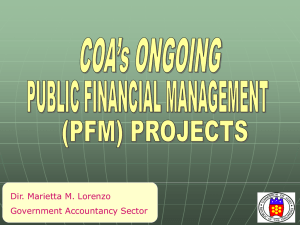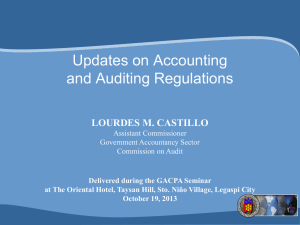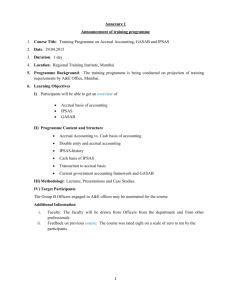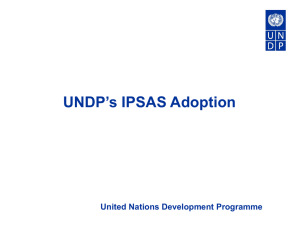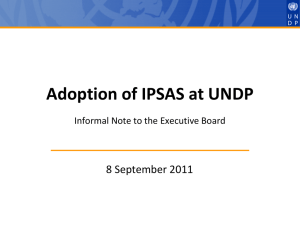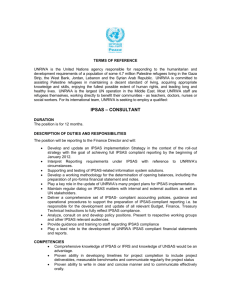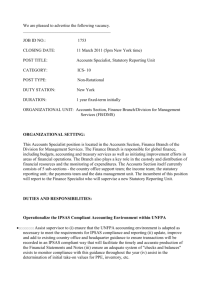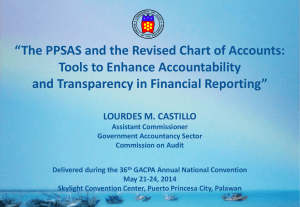PPSAS - Association of Government Accountants of the Philippines
advertisement
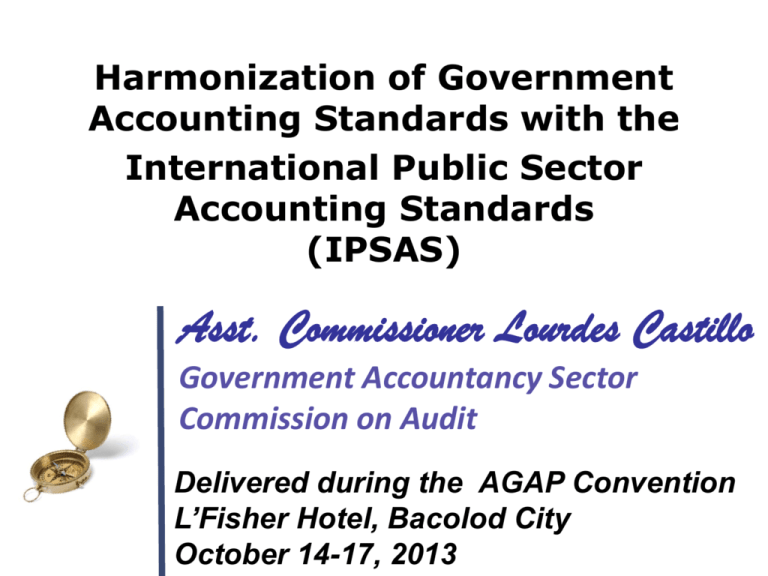
Harmonization of Government Accounting Standards with the International Public Sector Accounting Standards (IPSAS) Asst. Commissioner Lourdes Castillo Government Accountancy Sector Commission on Audit Delivered during the AGAP Convention L’Fisher Hotel, Bacolod City October 14-17, 2013 ROAD MAP to HARMONIZATION PROCESS I. II. III. AUTHORITY/LEGAL BASIS CREATION OF THE PUBLIC SECTOR ACCOUNTING STANDARDS BOARD (PSASB) PREPARATION OF THE PHILIPPINE PUBLIC SECTOR ACCOUNTING STANDARDS (PPSAS) • INTERNATIONAL PUBLIC SECTOR ACCOUNTING STANDARDS (IPSAS) • PHILIPPINE APPLICATION GUIDANCE (PAG) IV. IMPLEMENTATION AUTHORITY/LEGAL BASIS 1987 Philippine Constitution, Article IX D, 2(2) Section “The Commission shall have exclusive authority, subject to the limitations in this Article, to … XXX ... and promulgate accounting and auditing rules and regulations, including those for the prevention and disallowance of irregular, unnecessary, excessive, extravagant, or unconscionable expenditures or uses of government funds and properties.” AUTHORITY/LEGAL BASIS Presidential Decree (PD) 1445, State Audit Code of the Philippines, Sec. 25 (4) “(4) To promulgate auditing and accounting rules and regulations so as to facilitate the keeping, and enhance the information value, of the accounts of the government.” II. Creation of the PUBLIC SECTOR ACCOUNTING STANDARDS BOARD (PSASB) PUBLIC SECTOR ACCOUNTING STANDARDS BOARD (PSASB) Creation • 2008 Commission on Audit (COA) Organizational Restructuring pursuant to the 1987 Philippine Constitution, Section 2(2) Article IX-D. • COA Office Order No. 2010-118 dated February 19, 2010 PUBLIC SECTOR ACCOUNTING STANDARDS BOARD (PSASB) Function Assist the COA Commission Proper in formulating and implementing accounting standards for the public sector PUBLIC SECTOR ACCOUNTING STANDARDS BOARD (PSASB) Function Establish and maintain linkages with international bodies, professional organizations and academe on accounting related fields on financial management. III. Preparation of the PHILIPPINE PUBLIC SECTOR ACCOUNTING STANDARDS (PPSAS) OVERVIEW PPSAS • BASIS • OBJECTIVE • SCOPE • METHODOLOGY • CONTENT Philippine Public Sector Accounting Standards Basis • Pronouncements issued by IPSASB (IPSASs), IASB, PICPA, International Organization of Supreme Audit Institutions and others. • Relevant factors, including best accounting practices, and • Capacity of agencies to comply with PPSAS IPSAS Overview Philippine Public Sector Accounting Standards Objective • The PPSAS set out the recognition, measurement, presentation and disclosure requirements for financial reporting in the Philippine Government. • Transitional provisions shall be issued to address specific concerns not yet covered by the PPSAS. • Supplemental guidelines shall be issued when the need arises Philippine Public Sector Accounting Standards Scope PPSASs set out requirements dealing with transactions and other events in general purpose financial reports. PPSASs are designed to apply to the general purpose financial reports of all public sector entities other than Government Business Enterprises (GBEs). IPSAS Overview Philippine Public Sector Accounting Standards Scope applies to all NGAs, LGUs and GOCCs not classified as Government Business Enterprises GBEs Philippine Public Sector Accounting Standards Methodology I. Evaluation of IPSAS Study and detailed evaluation of each IPSAS to determine applicability. II. Development of PPSAS Provide the Philippine Application Guidance (PAG) for IPSAS provisions which were revised/modified or not to be adopted. Exposure Drafts Fundamental Issues (addressed by change in policy or disclosure requirements ) Focus Group Discussions Philippine Public Sector Accounting Standards Methodology III. Preparation/Update of Government Accounting Manual As PPSAS are being developed, provisions of the Government Accounting Manual are being studied and enhanced/modified, accordingly IV. Revision of the Chart of Accounts Chart of accounts was revised to conform with the PPSAS COA Circular 2013-002 dated Jan. 30, 2013 IPSAS Overview Philippine Public Sector Accounting Standards Content PPSAS consist of … International Public Sector Accounting Standards (IPSASs) (Accrual Based IPSAS per 2012 Handbook) developed by IPSASB and published by the International Federation of Accountants (IFAC), and Philippine Application Guidance (PAG) IPSAS Overview Philippine Public Sector Accounting Standards Philippine Application Guidance (PAG) • Provides supplementary guidance of IPSASs. • States the reason for not adopting or modifying some paragraphs of the IPSASs to suit the Philippine public sector situation. IPSAS Overview IV. Implementation of PHILIPPINE PUBLIC SECTOR ACCOUNTING STANDARDS (PPSAS) Philippine Public Sector Accounting Standards Approach to Implementation 28 out of 32 IPSAS shall be implemented Phased Implementation • Phase 1 (25 PPSAS for implementation in 2014) • Phase 2 (3 PPSAS for implementation in 2015) Philippine Public Sector Accounting Standards Phase 1 – For implementation in 2014 1. PPSAS 1 – Presentation of Financial Statements (IPSAS 1) 2. PPSAS 2 – Cash Flow Statements (IPSAS 2) 3. PPSAS 3 – Accounting Policies, Changes in Accounting Estimates and Errors (IPSAS 3) 4. PPSAS 4 – The Effects of Changes in FOREX rates (IPSAS 4) Philippine Public Sector Accounting Standards Phase 1 – for implementation in 2014 PPSAS 5 – Borrowing Costs (IPSAS 5) PPSAS 6 – Consolidated and Separate Financial Statements (IPSAS 6) 7. PPSAS 8 – Interests in Joint Venture (IPSAS 8) 8. PPSAS 9 – Revenue from Exchange Transactions (IPSAS 9) 9. PPSAS 12 – Inventories (IPSAS 12) 10. PPSAS 13 – Leases (IPSAS 13) 5. 6. Philippine Public Sector Accounting Standards Phase 1 (con’t) 11. PPSAS 14 – Events after the Reporting Date (IPSAS 14) 12. PPSAS 16 – Investment Property (IPSAS 16) 13. PPSAS 17 – Property, Plant and Equipment (IPSAS 17) 14. PPSAS 19 – Provisions, Contingent Liabilities and Assets (IPSAS 19) Philippine Public Sector Accounting Standards Phase 1 (con’t) 15. PPSAS 20 – Related Party Disclosures (IPSAS 20) 16. PPSAS 21 – Impairment of Non-Cash Generating Assets (IPSAS 21) 17. PPSAS 23 - Revenue from NonExchange Transactions (Taxes and Transfers) (IPSAS 23) 18. PPSAS 24 – Presentation of Budget Information in Financial Statements (IPSAS 24) Philippine Public Sector Accounting Standards Phase 1 (con’t) 19. PPSAS 26 – Impairment of Cash Generating Assets (IPSAS 26) 20. PPSAS 27 – Agriculture (IPSAS 27) 21. PPSAS 28 – Financial Instruments: Presentation (IPSAS 28) 22. PPSAS 29 – Financial Instruments: Recognition and Measurement (IPSAS 29) Philippine Public Sector Accounting Standards Phase 1 (con’t) 23. PPSAS 30 - Financial Instruments Disclosure (IPSAS 30) 24. PPSAS 31 – Intangible Assets (IPSAS 31) 25. PPSAS 32 - Service Concession Arrangements: Grantor (IPSAS 32) Philippine Public Sector Accounting Standards Phase 2 – For implementation in 2015 1. PPSAS 18 – Segment Reporting 2. PPSAS 22 – Disclosure of Information About the General Government Sector 3. PPSAS 25 – Employee Benefits PPSAS SUMMARY IPSAS Overview PPSAS 1 — Presentation of FS Objective of the Standard To set overall considerations for the: IPSAS Overview Presentation Structure Minimum content of Financial Statements PPSAS 1 — Presentation of FS Salient Features Accrual basis except for transactions required by law to be on modified accrual basis Comparative Information - for all amounts reported in the FS - for all relevant narrative and descriptive information IPSAS Overview PPSAS 1 — Presentation of FS Complete set of Financial Statements 1. Statement of financial position 2. Statement of financial performance 3. Statement of changes in net assets/equity 4. Notes, comprising a summary of significant accounting policies and other explanatory notes 5. Separate additional financial statement for comparison of budget and actual amounts shall be prepared and submitted. IPSAS Overview PPSAS 2 — Cash Flows Statement Objective of the Standard Provision of information about changes in cash and cash equivalents by means of a cash flow statement. Classifies cash flows during the period from operating, investing, and financing activities. IPSAS Overview PPSAS 2 — Cash Flows Statement Salient Features Cash flows for operating activities are reported using the direct method. Cash flows exclude movements between items that constitute cash or cash equivalents, Investing and financing transactions that do not require the use of cash shall be excluded from the cash flow statement, but they shall be separately disclosed. IPSAS Overview PPSAS 3 - Accounting Policies, Changes in Accounting Estimates and Errors Salient Features CHANGE IN ACCOUNTING POLICY Follow transition requirements If the change is voluntary, apply the new accounting policy retrospectively by restating prior periods. IPSAS Overview PPSAS 3 - Accounting Policies, Changes in Accounting Estimates and Errors Salient Features Changes in Accounting Estimates Effect of a change in estimate is accounted for by including it in net income or comprehensive income as appropriate in: a. The period of change if the change affects that period only b. The period of change and future periods if the change affects both IPSAS Overview PPSAS 4 - The Effects of Changes in Foreign Exchange Rates Salient Features Covers Foreign currency transactions and Foreign operations Translation should be done for foreign currency items into functional currency Initial recognition and measurement record the spot exchange rate IPSAS Overview PPSAS 5 - Borrowing Costs Salient Features Borrowing costs shall be charged to expenses in the period when they are incurred. (Benchmark treatment) Borrowing costs directly attributable to the acquisition, construction, or production of a qualifying asset shall be capitalized as part of the cost of that asset. (Allowed Alternative Treatment) IPSAS Overview PPSAS 5 - Borrowing Costs Salient Features For borrowing costs pertaining to loans borrowed by the National Government (NG) which are recorded by the Bureau of the Treasury, the benchmark treatment shall be used. However for loans borrowed directly by the NGAs and LGUs, the allowed alternative treatment shall be used. IPSAS Overview PPSAS 6 - Consolidated and Separate Financial Statement Salient Features prescribes requirements for preparing and presenting consolidated FS for an economic entity under the accrual basis of accounting A controlled entity is an entity controlled by another entity, known as the controlling entity. Balances, transactions, revenue and expenses between entities within the economic entity are eliminated in full. IPSAS Overview PPSAS 8 - Interests in Joint Ventures Salient Features The key characteristic of a joint venture is a binding arrangement whereby two or more parties are committed to undertake an activity that is subject to joint control. Joint ventures may be classified as jointly controlled operations, jointly controlled assets and jointly controlled entities. Different accounting treatments apply for each type of joint venture. IPSAS Overview PPSAS - 9 Revenue from Exchange Transactions Salient Features Applies to revenue arising from the following exchange transactions and events: The rendering of services; The sale of goods, and The use of others of entity assets yielding interest, royalties and dividends. Revenue shall be measured at the fair value of the consideration received or receivable. IPSAS Overview PPSAS 12 - Inventories Salient Features Inventories are measured at the lower of cost and net realizable value. If acquired through a non-exchange transaction, their cost shall be measured as their fair value as at the date of acquisition. Cost is determined on weighted average basis Write-downs to net realizable value are recognized as an expense. Reversals arising from an increase in net realizable value are recognized as a reduction of the inventory expense in the period in which they occur. IPSAS Overview Salient Features PPSAS 13 Leases Lease is classified as a Finance lease if: (a) The lease transfers ownership of the asset to the lessee by the end of the lease term; (b) The lessee has the option to purchase the asset at a price that is expected to be sufficiently lower than the fair value (c) The lease term is for the major part of the economic life of the asset Operating lease does not transfer substantially all the risks and rewards incidental to ownership of the asset. IPSAS Overview PPSAS 14 Events After the Reporting Date DEFINITIONS Adjusting events after the reporting date – events that provide evidence of conditions that existed at the reporting date Non-adjusting events after the reporting date those that are indicative of conditions that arose after the reporting date An entity shall disclose : • the date its financial statements were authorized for issue and • who gave that authorization. IPSAS Overview IPSAS 16 Investment Property Salient Features Investment property - is property (land or a building – or part of a building – or both) held to earn rentals or for capital appreciation, or both, rather than for: a) Use in the production or supply of goods or services, or for administrative purposes; or b) Sale in the ordinary course of operations. Investment property shall be measured initially at cost. If acquired through non-exchange transaction – Fair value as at date of acquisition. IPSAS Overview PPSAS 17 - Property, Plant and Equipment Salient Features Recognition of Heritage Assets Initial recognition is at cost. Where an asset is acquired at no cost, or for a nominal cost, its cost is its fair value as at the date of acquisition. Infrastructure assets are accounted as PPE The carrying amount of an item of property, plant, and equipment shall be derecognized: (a) On disposal; or (b) When no future economic benefits or service potential is expected from its use or disposal. IPSAS Overview PPSAS 19 - Provisions, Contingent Liabilities and Contingent Assets Salient Features Recognize a provision only when: a past event has created a present legal or constructive obligation, an outflow of resources to settle the obligation is probable, and there is a reliable estimate of the obligation IPSAS Overview PPSAS 19 - Provisions, Contingent Liabilities and Contingent Assets Salient Features Contingent liability arises when there is: possible obligation to be confirmed by a future event that is outside the control of the entity; or a present obligation may, but probably will not, require an outflow of resources; or a reliable estimate cannot be made. Contingent liabilities require disclosure only (no recognition). If the possibility of outflow is remote, then no disclosure. IPSAS Overview PPSAS 20 - Related Party Disclosures Salient Features Related parties are parties that control or have significant influence over the reporting entity and parties that are controlled or significantly influenced by the reporting entity Requires disclosure of: – relationships involving control, even when there have been no transactions in between; – related party transactions; and – management compensation IPSAS Overview PPSAS 21 - Impairment of NonCash-Generating Assets Definition Cash-generating assets - are assets held with the primary objective of generating a commercial return. Non-cash-generating assets - are assets other than cash-generating assets Impairment - a loss in the future economic benefits or service potential of an asset, over and above the systematic recognition of the loss of the asset’s future economic benefits or service potential through depreciation. IPSAS Overview PPSAS 21 - Impairment of NonCash-Generating Assets Salient Features A non-cash-generating asset is impaired when the carrying amount of the asset exceeds its recoverable service amount. An impairment loss shall be recognized immediately in surplus or deficit. After the recognition of an impairment loss, the depreciation charge for the asset shall be adjusted in future periods IPSAS Overview PPSAS 23 - Revenue from Non-Exchange Transactions (Taxes and Transfers) Non-exchange transactions Examples: (a) Taxes; and (b) Transfers (whether cash or noncash) An asset acquired through a non exchange transaction shall initially be measured at its fair value as at the date of acquisition. An entity shall recognize an asset in respect of taxes when the taxable event occurs and the asset recognition criteria are met. IPSAS Overview PPSAS 24 - Presentation of Budget Information in Financial Statements Salient Features PPSAS 24 requires … Presentation of budget information in the financial statements when the reporting entity is publicly accountable for its budget. Disclosure of an explanation of the reasons for material differences between the budget and actual amounts. IPSAS Overview To ensure that public sector entities discharge their accountability obligations and enhance the transparency of their financial statements PPSAS 26 - Impairment of CashGenerating Assets Definition Cash-Generating Assets (CGA) – assets held with the primary objective of generating a commercial return. Impairment - a loss in the future economic benefits or service potential of an asset An impairment loss of a cash-generating asset is the amount by which the carrying amount of an asset exceeds its recoverable amount. IPSAS Overview PPSAS 27 - Agriculture Salient Features Prescribes the accounting treatment and disclosures related to agricultural activity Agricultural activity - management by an entity of the biological assets for sale, or for distribution at no charge or for a nominal charge or for conversion into agricultural produce or into additional biological assets. IPSAS Overview PPSAS 28 - Financial Instruments: Presentation Prescribes principles for classifying and presenting financial instruments as liabilities or net assets/equity, and for offsetting financial assets and liabilities. IPSAS 29 Financial Instruments: Recognition and Measurement Establishes principles for recognizing, derecognizing and measuring financial assets and financial liabilities. IPSAS 30 Financial Instruments: Disclosure Prescribe disclosures that enable financial statement users to evaluate the significance of financial instruments to an entity, the nature and extent of their risks, and how the entity manages IPSAS those risks. Overview PPSAS 31- Intangible Assets Salient Features Intangible Asset is an identifiable non-monetary asset without physical substance. An intangible asset, whether purchased or selfcreated, is recognized if: it is probable that the future economic benefits or service potential that are attributable to the asset will flow to the entity; and the cost or fair value of the asset can be measured reliably. All research costs are charged to expense when IPSAS Overview incurred. PPSAS 32—SERVICE CONCESSION ARRANGEMENTS: GRANTOR • Grantor – public sector entity grants service concession arrangements • Operator – private sector which manages the service concession asset • Service concession arrangement – sets performance standards, mechanisms for adjusting prices, and arrangements for arbitrating disputes. • Service concession assets – turned over to the grantor IPSAS Overview PPSAS 32—SERVICE CONCESSION ARRANGEMENTS: GRANTOR • Recognize by the grantor if: • It controls or regulates services (what, to whom and at what price) and • It controls any significant residual interest at the end of the arrangement • Initial recognition – fair value • Measurement after recognition – cost (like PPE or Intangible Assets) IPSAS Overview PPSAS 32—SERVICE CONCESSION ARRANGEMENTS: GRANTOR • Recognize liability when the grantor recognizes a service concession asset • Financial liability • Unearned income • Initial measurement – same amount as the asset adjusted by any consideration given by the grantor or the operator or from the operator to the grantor. IPSAS Overview PPSAS 32—SERVICE CONCESSION ARRANGEMENTS: GRANTOR (b) The operator is compensated for its services over the period of the service concession arrangement. IPSAS Overview Significant COA Issuances on ACCOUNTING and AUDITING RULES AND REGULATIONS 62 Significant COA ISSUANCES 1. COA Circular No. 2013-002 dated January 30, 2013 “Adoption of the Revised Chart of Accounts for National Government Agencies” 2. COA-DBM-DOF Joint Circular No. 2013-1 dated March 15, 2013 “Adoption of the Unified Accounts Code Structure (UACS)” 63 Significant COA ISSUANCES 3. COA Circular No. 2013-003 dtd. Oct. 29, 2013 “Updated Guidelines on the Prevention and Disallowance of Irregular, Unnecessary, Excessive, Extravagant and Unconscionable Expenses” 4. COA Circular No. 2013-007 dtd. Sept. 18, 2013 “Revised Guidelines on the Submission of Quarterly Accountability Reports on Appropriations, Allotments, Obligations and Disbursements” 64 Significant COA ISSUANCES 5. COA Circular No. 2012-005 dtd. Dec. 7, 2012 “Revocation of COA Circular No. 2009-008 dtd. Nov. 9, 2009 and Prescribing the Use of Punong Barangay’s Certification (PBC) and COA Auditor’s Advice (CAA)” 6. eNGAS Rollout in the Local Government Units 65 COA REVISED CHART OF ACCOUNTS COA Circular No. 2013-002 dated January 30, 2013 Effectivity date: January 01, 2014 66 OBJECTIVES To provide new accounts for the adoption of the Philippine Public Sector Accounting Standards (harmonized with IPSAS) To provide uniform accounts for national government accounting and budget systems to facilitate the preparation of harmonized financial and budgetary accountability reports 67 OBJECTIVES To expand the account code from three (3) digits in the NGAS Chart of Accounts, to eight (8) digits, to allow expansion or creation of new accounts as may be necessary to implement new standards or policies and provide up to four levels of consolidation depending on the users’ information needs. 68 MAJOR CHANGES a. Coverage is limited only to all national government agencies and GOCCs receiving funds constituted a SAGF from the National Government b. Expanded account code structure from three (3) digits to eight (8) digits 69 MAJOR CHANGES c. New accounts were provided for the implementation of the Philippine Public Sector Accounting Standards (PPSAS) d. Some accounts were deleted since these accounts are for use by local government units or government-owned and/or controlled corporations, while other accounts are no longer applicable to national government agencies. 70 MAJOR CHANGES e. Some accounts were either expanded or compressed. For instance, expense accounts for repairs and maintenance and depreciation of property, plant and equipment which were previously presented per asset account were compressed based on the major account classification 71 COA-DBM Joint Circular No. 2013-1 dated March 15, 2013 “Revised Guidelines on the Submission of Quarterly Accountability Reports on Appropriations, Allotments, Obligations and Disbursements” 72 RATIONALE COA and DBM requirement for agencies to submit BAR/FAR. DBM uses the reports to monitor agency performance for policy making purposes. COA uses the report to prepare the AFR. 73 PURPOSES 1. To prescribe harmonized formats of the financial accountability reports (FAR) on appropriations, allotments, obligations, disbursement authorities, disbursements and balances; and 2. To prescribe guidelines on the preparation and timely submissions of FARs by the agencies to the DBM and the COA after the end of each quarter. 74 COVERAGE The Circular covers all departments, bureaus, offices and agencies of the national government and governmentowned and/or controlled corporations maintaining Special Accounts in the General Fund. 75 GUIDELINES A. Head of Office to submit the following reports to COA and DBM: 1. Statement of Appropriations, Allotments, Obligations, Disbursements and Balances (SAAODB)) 2. List of Agency Budget Matrix (ABM) or SAROs and Sub-AROs 76 GUIDELINES 3. Detailed Statement of Current Year’s Obligations, Disbursements and Unpaid Obligations (SODUO-CY) 4. Summary of Prior Year’s Obligations, Disbursements and Unpaid Obligations (SODUO-PY) 5. Summary of Report of Disbursements 77 GUIDELINES A. The FARs prescribed in the Circular shall replace the following DBM and COA reports as follows: 1. DBM Statement of Allotments, Obligations and Balances (SAOB) - BAR No. 4 Financial Report of Operations - BAR No. 2) Financial Report of Operations - BAR No. 2) 78 GUIDELINES 2. COA SAOB Detailed Breakdown of Obligations Detailed Breakdown of Disbursements Regional Breakdown of Expenses Statement of Cumulative Allotments, Obligations Incurred and Unobligated Balances Detailed Statement of Cumulative Expenditures/ Obligations Incurred, Obligations Liquidated/Disbursements and Unliquidated Obligations 79 RESPONSIBILITIES 1. The FARs shall be prepared and certified correct by the following officials: Budget Officer/Head of Budget Unit – for the portion of the report pertaining to appropriations, allotments, obligations, unobligated allotments and unreleased appropriations Chief Accountant/Head of Accounting Unit – for the portion of the report pertaining to disbursements and unpaid obligations The FARs shall be signed by the Agency Head as the approving official. He/she shall ensure the timely submission of the accurate and reliable FARs. 80 DUE DATES OF SUBMISSION to COA and DBM All Departments/Agencies – not later than the 30th day after the end of each quarter The Lower Operating Units – within (5) days after the end of each quarter for consolidation The Agency Regional Offices – to submit the consolidated report to COA (GAS) and DBM CO within (10) days after the end of each quarter 81 COA Circular No. 2012-003 dated October 29, 2012 “Updated Guidelines for the Prevention of Disallowance of Irregular, Unnecessary, Excessive, Extravagant and Unconscionable Expenses as enumerated under COA Circular No. 85-55A dated Sept. 8, 1985” 82 LEGAL BASIS Section 2(2), Article IX-D of the 1987 Constitution Section 33 of P.D. 1445 83 DEFINITION 1. “Irregular” Expenditures Expenditures incurred without adhering to established rules, regulations, procedural guidelines, policies, principles or practices that have gained recognition in laws Transactions conducted in a manner that deviates or departs from, or which does not comply with standards set 84 DEFINITION 2. “Unnecessary” Expenditures Expenditures which could not pass the test of prudence or the diligence of a good father of a family, thereby denoting non-responsiveness to the exigencies of the service Not supportive of the implementation of the objectives and mission of the agency relative to the nature of its operation Not dictated by the demands of good government, and those, the utility of which cannot be ascertained at a specific time Not essential or that which can be dispensed with without loss or damage to property 85 DEFINITION 3. “Excessive” Expenditures Signify unreasonable expense or expense incurred at an immoderate quantity and exorbitant price Include expenses which exceed what is usual or proper, as well as expenses which are unreasonably high and beyond just measure or amount 86 DEFINITION 4. “Extravagant” Expenditures Signify those incurred without restraint, judiciousness and economy Exceed the bounds of propriety Immoderate, prodigal, lavish, luxurious, grossly excessive, and injudicious 87 DEFINITION 5. “Unconscionable” Expenditures Pertain to expenditures which are unreasonable and immoderate, and which no man in his right sense would make, nor a fair and honest man would accept as reasonable, and those incurred in violation of ethical and moral standards 88 COA Circular No. 2013-007 dated September 18, 2013 “Guidelines for the Use of Electronic Official Receipts (eORs) to Acknowledge Collection of Income and Other Receipts of Government” 89 LEGAL BASIS Section 7 of R.A. No. 8792, otherwise known as the Electronic Commerce Act of 2000 COA Circular No. 2004-006 dated Sept. 9, 2004, setting the guidelines and principles on the acceptability of evidences of receipt of payments 90 RATIONALE/SCOPE Electronic Collection System is an active online facility provided by government agencies that enables debtors, creditors and other clients to pay government dues and charges through a computer or telephone. A system for receiving, sending, storing, generating, or otherwise processing electronic data messages or electronic documents pertaining to receipt and deposit of government collections. A system for receiving, sending, storing, generating, or otherwise processing electronic data messages or electronic documents pertaining to receipt and deposit of government collections. 91 SALIENT FEATURES The electronic document maintains its integrity and reliability and can be authenticated. For evidentiary purposes, an electronic document shall be the functional equivalent of a written document under existing laws. 92 GENERAL GUIDELINES 1. All collections shall be acknowledged by the government agency concerned through the issuance of official receipts to establish that these have been received. 2. Receipt of collections/revenue through electronic means shall be acknowledged by an eOR. 3. The eORs shall have met the minimum data content. 4. Collections of NGAs shall be deposited to the national Treasury while those f or LGUs and GOCCs shall be deposited to their respective accounts. 93 GENERAL GUIDELINES 5. All collections through electronic system shall be recorded/accounted for in the books of the concerned government agency. 6. The government agency concerned shall comply with the Joint Administrative Order No. 02, s.2006, “Guidelines Implementing R.A. No. 8792 on EPCS in Government”. 7. The government agency shall provide the Auditor the read/view and print access rights in the computerized system. 94 COA Circular No. 2012-005 dated December 7, 2012 “Revocation of COA Circular 2009-008 dated Nov. 9, 2009 and Prescribing the Use of Punong Barangay’s Certification (PBC) and COA Auditor’s Advice (CAA)” 95 SALIENT FEATURES The responsibility to initiate , process, approve financial transactions and issue Punong Barangay’s Certification (PBC) under oath rests with the Barangay officials. The PBC to be issued only under oath after the PB has duly examined and been satisfied that: The DVs are duly certified and approved, The expenditure or disbursement is proper and valid, and The supporting documents are complete. 96 SALIENT FEATURES The PB shall be primarily accountable for all losses arising from issuance of the PBC. The Authorized Government Depository Bank (AGDB) shall encash the checks issued if the corresponding PBC is issued. Checks encashed without the corresponding PBC or with falsified PBC shall be the responsibility of the AGDB. The PBC shall be numbered sequentially by year and by barangay and in (4) copies. 97 SALIENT FEATURES The PBC (4th) copy shall be submitted to the accountant for recording within (10) days after end of month and subsequently submitted to the COA auditor for audit. Non-submission of PBCs within (15) days after demand by the Auditor shall be a ground for preparation of the COA Auditor’s Advice (CAA) to the AGDB to hold further payments of checks issued by the said barangay. 98 eNGAS Rollout in the LGUs Will now resume with the assistance of the eNGAS Users’ Circle (EUC), the lone organization who signified interest in helping COA with the rollout in the LGUs. Memorandum of Agreement (MOA) will be made to embody the terms and conditions for the rollout. This activity to be headed by the COA Information Technology Office (ITO) and with the active participation of the Government Accountancy Sector (GAS). 99 “When the people become involved in their government, government becomes more accountable, and our society is stronger, more compassionate, and better prepared for the challenges of the future.” - Arnold Schwarzenegger 100 “We have a problem when the same people who make the law get to decide whether or not they themselves have broken the law.” - Michael Templet 101 “I am responsible. Although I may not be able to prevent the worst from happening, I am responsible for my attitude toward the inevitable misfortunes that darken life.” -Walter Anderson 102 Thank You!

